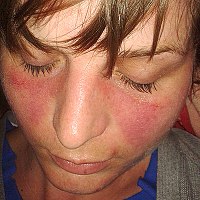
Photo from wikipedia
OBJECTIVES Long-term real-world management of inflammatory rheumatic diseases remains unclear, especially with the advent of new treatment options. This study characterizes the number of advanced treatments used by patients with… Click to show full abstract
OBJECTIVES Long-term real-world management of inflammatory rheumatic diseases remains unclear, especially with the advent of new treatment options. This study characterizes the number of advanced treatments used by patients with selected rheumatic diseases (rheumatoid arthritis [RA], psoriatic arthritis [PsA], ankylosing spondylitis, juvenile idiopathic arthritis) and provides a contemporary portrait of treatment patterns and therapeutic sequencing among patients with RA and PsA. METHOD Patients were selected from a large US claims database and classified into disease subsamples based on the latest rheumatic diagnosis recorded before/on the day of initiation of the first advanced treatment (index date). The total number of advanced treatments was assessed within the first 5 years following the index date. Treatment patterns and therapeutic sequencing were assessed over the first 2 years. RESULTS Approximately 20% of patients received ≥2 distinct advanced treatments during the first year following index date - the proportion increased to almost 50% among patients with 5 years of observation. Most patients (RA: 76.8%; PsA: 88.7%) initiated a tumor necrosis factor as the first advanced treatment. Over the first 2 years after the index date, 1/3 of RA and PsA patients switched to another advanced treatment. More than 50% initiated a second treatment with the same mechanism of action (MOA). A small proportion of patients received a biosimilar. CONCLUSION Despite advent of treatments with different MOA, cycling between treatments with the same MOA was common. Further studies with longer data follow-up would be needed to assess the impact of higher adoption of biosimilars on treatment patterns/sequencing.
Journal Title: Current medical research and opinion
Year Published: 2021
Link to full text (if available)
Share on Social Media: Sign Up to like & get
recommendations!